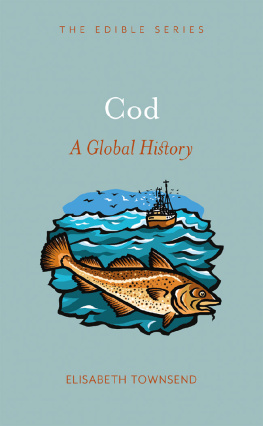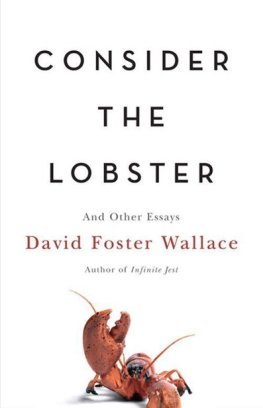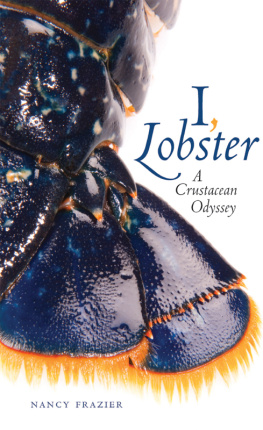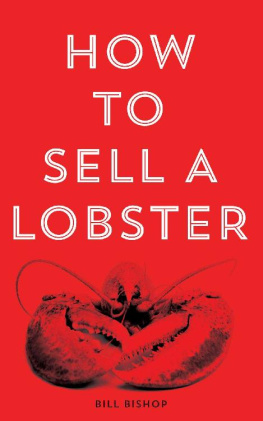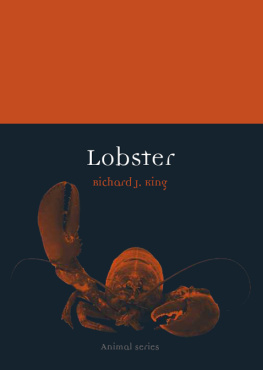LOBSTER

Edible
Series Editor: Andrew F. Smith
EDIBLE is a revolutionary new series of books dedicated to food and drink that explores the rich history of cuisine. Each book reveals the global history and culture of one type of food or beverage.
Already published
Cake Nicola Humble Caviar Nichola Fletcher Cheese Andrew Dalby Chocolate Sarah Moss and
Alexander Badenoch Curry Colleen Taylor Sen Dates Nawal Nasrallah Hamburger Andrew F. Smith Hot Dog Bruce Kraig Ice Cream Laura B. Weiss | Milk Hannah Velten Pancake Ken Albala Pie Janet Clarkson Pizza Carol Helstosky Potato Andrew F. Smith Sandwich Bee Wilson Soup Janet Clarkson Spices Fred Czarra Tea Helen Saberi Whiskey Kevin R. Kosar |
Lobster
A Global History
Elisabeth Townsend
REAKTION BOOKS
To Jeff with love and gratitude
Published by Reaktion Books Ltd
33 Great Sutton Street
London EC1V 0DX, UK
www.reaktionbooks.co.uk
First published 2011
Copyright Elisabeth Townsend 2011
All rights reserved
No part of this publication may be reproduced,
stored in a retrieval system, or transmitted, in any form or
by any means, electronic, mechanical, photocopying, recording
or otherwise, without the prior permission of the publishers.
Page references in the Photo Acknowledgements and
Index match the printed edition of this book.
Printed and bound in China by C&C Offset Printing Co. Ltd
British Library Cataloguing in Publication Data
Townsend, Elisabeth.
Lobster: a global history. (Edible)
1. Lobsters. 2. Lobster fisheries History.
3. Cooking (Lobsters)
4. Cooking (Lobsters) History.
I. Title II. Series
641.3 95-DC22
eISBN:9781861899958
Contents

Introduction:
What is a Lobster?

The worlds love affair with lobster began out of necessity. It wasnt a mutual affection though: it was as lopsided as un-requited love. Humans needed to eat and the crustacean was often within easy reach by hand, spear, long hook, baskets and later nets and traps. But the shellfish eventually became more than just grub its status shifted from vital protein to paupers food to cultural icon.
This relationship has always been complex. When lobsters were abundant many coastal dwellers disdained them. But their popularity with wealthy urban diners drove innovations that nearly annihilated the stocks. It was through these innovations and mass marketing that lobster ended up on dinner plates in Tokyo, Japan and Dubuque, Iowa. Clearly, this affaire damour isnt a tawdry fling. Its a long-term relationship.
The worldwide lobster industry is still thriving because early regulations prevented overfishing. Yet worry about losing the species continues amid record catches and several perplexing scares, and today lobsters and their consumers are under another threat. As concern about the humane treatment of lobsters heats up, demand may decline as purveyors become reluctant to sell them. Compassion is building for allanimals and that includes the lobster. Some countries are considering broadening animal welfare laws to include these lively shellfish. Once again new technology is a significant factor with new killing machines that use electrocution and water pressure. Divorced from the primal experience of killing our dinner, we are in danger of losing the connection between the food we ingest and its origin. The idyllic experience of eating a freshly boiled lobster on a coastal dock may become extinct. If that happens, will anyone recognize the feisty iconic shellfish on Salvador Dals Lobster Telephone or on Maines licence plate? Will we even remember what lobsters symbolize summertime leisure on the rockbound coast, eating exquisite seafood with friends provided by independent fisherwomen and men braving the elements to bring in the catch? What happens to the experience of eating a lobster?
Humans and lobsters have a long history together. Long before we knew much about this crustacean, lobsters found their way into artistic creations as a revered shellfish, symbol, status or otherwise. Spiny lobsters adorn a fifteenth-century BC Egyptian temple in an aquatic scene depicting new, fascinating animals and plants from an expedition down the Red Sea along the coast of East Africa. As early as the first century BC, spiny lobsters appeared in a mosaic floor in the dining room of ancient Pompeii and in Virgils Aeneid, as Palinurus, the helmsman of the Trojan fleet. They are part of a mosaic floor in the dining room of a Pompeian house depicting how the floor would look after the diners had finished leaving the inedible shells and bones dropped under the tables.
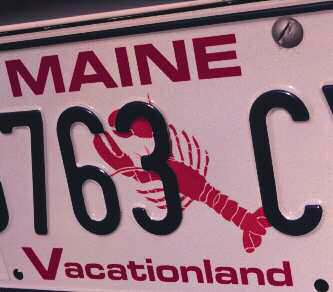
Lobsters adorn everything from Maine licence plates to fine art, literature and movies.
Humans are still captivated by lobster. But most lobster lovers know less about them than some of the early Egyptians or Peruvians or Italians. To begin our introduction to the fascinating history of lobsters and their consumption, meet Fiona. She is dressed in a spotted orange and yellow outfit. At seven years old, she weighs a pound and three-quarters (800 g). And because of her spiffy get-up, she is about as unusual as say one in 30 million. This youngster, probably a yellow lobster in spite of her orange spots, was caught in Canada near Prince Edward Island in 2009. Instead of being sold as a lobster dinner, she lives in a tank with close to 100 other lobsters in Arnolds Lobster and Clam Bar in Eastham, Massachusetts and may be donated to an aquarium. She was named for owner Nathan Nickersons girlfriends granddaughter. How Fiona survived is still a mystery. Usually lobsters in the Atlantic Ocean are a greenishbrown or a blackish blue so they blend into their habitat. Fiona is the product of a rare genetic mutation, and would be an easy target for predators in her yellow shell, as are the scarce royal blue, red, white and even two-toned lobsters. All of these except the white ones turn red when cooked, as do lobsters worldwide, writes Dr Robert Bayer, an American lobster researcher. But she does have two powerful weapons to defend herself her claws.
Fiona is one of two distinct varieties of lobsters clawed and clawless that are worthy of any food lovers attention and commercially important. In Fionas family there are three noteworthy clawed lobsters. She is the American in a group of European and Norway lobsters that are found in the colder, northern Atlantic Ocean. But she is not the only beauty. The clawless group comprises the sometimes stunning, ubiquitousspiny lobsters of warmer, tropical waters primarily in Australasia, plus their cousins, the slipper lobsters and furry lobsters.
What do they have in common? All lobsters are treasured for their firm, sweet white meat, which is satisfyingly full of flavour and... remarkably similar the world over, said British chef Rick Stein, who advocates eating lobster where they come right out of the ocean. All are sold live, as frozen tails or cooked, and have ten legs on the underside, as they are in the decapod family.


